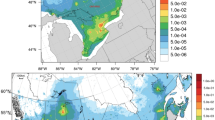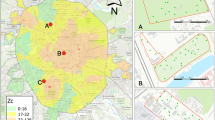Abstract
Relatively high activity concentrations of some radionuclides (226Ra, 238U, 232Th, and 40K) have been measured in surface and subsurface soils in areas (southern Iraq) where many warfare actions have taken place during the Iran–Iraq and Gulf wars. Such high activity concentrations might be related to the increase in cancerous injuries and birth defects recently reported. The study was aimed to estimate the activity concentrations of some nuclides and a comparison of results with international health hazard indices. In addition, the excess lifetime cancer risk (ELCR) was assessed. Soil samples were collected at three depths (0, 30, and 60 cm) in three locations in Abu Al Khasib and Ad Dayr in Basrah governorates. The average activity concentrations were estimated employing hyper-pure germanium HPGe gamma-ray detection technology. The values obtained in Abu Al Khasib were: 58.44 Bq/kg (226Ra), 43.56 Bq/kg (238U), 19.38 Bq/kg (232Th), and 321.76 Bq/kg (40K) whereas in Ad Dayr 45.71 Bq/kg (226Ra), 35.53 Bq/kg (238U), 20.33 Bq/kg (232Th), and 337.02 Bq/kg (40K). According to UNSCEAR (Sources and effects of ionizing radiations: a report on the effects of atomic radiation to the general assembly with scientific annexes, Annex B, United Nations, New York, 2000) report, higher levels of 226Ra, 238U concentrations than the world’s average values (35 Bq/kg) were observed in both locations. In addition, some radiation hazard indices were determined for both locations: average outdoor external dose (D out), average indoor external dose (D in), total average value of the external dose (D tot), average annual outdoor effective dose (E out), average annual indoor effective dose (E in), and averaged total annual effective dose (E tot). Values for D tot and E tot were higher than the worldwide median (143 nGy/h and 0.48 mSv/y, respectively) in both regions. The measured values of activity concentrations were also used to estimate the outdoor, indoor, and total ELCR. The ELCR values were higher than the worldwide averages. Further analyses and studies need to assess the real risks for human health and possible soil remediation.



Similar content being viewed by others
References
Agbalagba EO, Onoja RA (2011) Evaluation of natural radioactivity in soil, sediment and water samples of Niger Delta (Biseni) flood plain lakes, Nigeria. J Environ Radioact 102:667–671
Alaamer AS (2008) Assessment of human exposures to natural sources of radiation in soil of Riyadh, Saudi Arabia. Turk J Eng Environ Sci 32:229–234
Askouri NA, Hussain MO, Al-Ojaily A-RSS (2011) Natural radioactivity survey in Al-Jabal Al-Gharbi Mountain Region Libya; Iraq. J Phys 9:96–101
Aytas S, Yusan S, Aslani MA, Karali T, Turkozu DA, Gok C, Erenturk S, Gokce M, Oguz KF (2012) Natural radioactivity of riverbank sediments of the Maritza and Tundja Rivers in Turkey. J Environ Sci Health A Tox Hazard Subst Environ Eng 47(13):2163–2172. doi:10.1080/10934529.2012.696436
BCRG (Basrah Cancer Research Group) (2010) Cancer in Basrah: epidemiological analysis of incident cancer 2005–2008. Dar AlKutub for Press and Publication, Basrah
Beck HL (1980) Exposure rate conversion factors for radionuclides deposited on the ground. Report no. EML-378. Department of Energy, Environmental Measurements Lab, New York, USA. doi:10.2172/5239273
Brenner DJ, Sachs KS (2006) Estimating radiation-induced cancer risks at very low doses: rationale for using a linear no-threshold approach. Radiat Environ Biophys 44:253–256
Burnham JU (1991) Dose limits and risks. In: Burnham JU (ed) radiation protection. The international commission on radiological protection (ICRP) publication 60. Brunswick, Canada, pp 109–128
Clouvas A, Xanthos S, Antonopoulos-Domis M, Silva J (2000) Monte Carlo calculation of dose rate conversion factors for external exposure to photon emitters in soils. Health Phys 78:295–302
Dizman S, Görür FK, Keser R (2016) Determination of radioactivity levels of soil samples and the excess of lifetime cancer risk in Rize province, Turkey. Int J Radiat Res 14(3):237–244
Ebaid YY (2010) Use of gamma-ray spectrometry for uranium isotopic analysis of environmental samples. Rom J Phys 55(1–2):69–74
EC (European Commission) (1999) Radiological protection principles concerning the natural radioactivity of building materials. Radiation Protection 112, Brussels, Belgium
Emelue HU, Jibiri NN, Eke BC (2014) Excess lifetime cancer risk due to gamma radiation in and around Warri refining and petrochemical company in Niger Delta Nigeria. BJMMR 4(13):2590–2598. doi:10.9734/BJMMR/2014/7180
Faanu A, Adukpo OK, Tettey-Larbi L, Lawluvi H, Kpeglo DO, Darko EO, Emi-Reynolds G, Awudu RA, Kansaana C, Amoah PA, Efa AO, Ibrahim AD, Agyeman B, Kpodzro R, Agyeman L (2016) Natural radioactivity levels in soils, rocks and water at a mining concession of Perseus gold mine and surrounding towns in Central Region of Ghana. SpringerPlus 5:98. doi:10.1186/s40064-016-1716-5
Habib OS, Al-Diab JMA, Mohsin A et al (2010) Experience and outcome of population-based cancer registration in Basrah-southern Iraq in four years (2005–2008). Asian Pac J Cancer Prev 11:1151–1154
IAEA (International Atomic Energy Agency) (1996) Radiation safety standard series. Regulation for the safe transport of radioactive material. IAEA Division of Public Information, 96-00725 IAEA/PI/A47E, Vienna, Austria
IAEA (International Atomic Energy Agency) (2011) Radioactive particles in the environment: sources, particle characterization and analytical techniques. IAEA-TECDOC-1663. ISBN: 978-92-0-119010-9, Vienna, Austria
Jallad KN (2013) Radioactive investigation of sand from the northern region of Kuwait. Environ Nat Resour Res 3(4):68–77
Jallad KN (2015) Radioactive characterization of sand samples from Failaka Island in Kuwait. J Radioanal Nucl Chem 303:733–741
Moore RJ (1993) Imaging principles of cardiac angiography. Aspen, Rockville
NCRP (National Council on Radiation Protection and Measurement) (1975) Natural background radiation in the United States, soil radioactivity no. 45, Washington, DC
Nguelem EJM, Ndontchueng MM, Motapon O (2016) Determination of 226Ra, 232Th, 40K, 235U and 238U activity concentration and public dose assessment in soil samples from bauxite core deposits in Western Cameroon. Springerplus 5(1):1253. doi:10.1186/s40064-016-2895-9
Nwankwoa CU, Ogundarea FO, Folleya DE (2015) Radioactivity concentration variation with depth and assessment of workers’ doses in selected mining sites. J Radiat Res Appl Sci 8(2):216–220. doi:10.1016/j.jrras.2015.01.004
Queck B (2012) Dipl. Staatwissenschaftlerin Foreign Policy [Blog post]. http://serbiasos.blogspot.com/2013/02/depleted-uraniumweapons-are-nuclear.html. Accessed 25 Jan 2017
Quindos LS, Fernandez PL, Rodenas C, Gomez-Arozamena J, Arteche J (2004) Conversion factors for external gamma dose derived from natural radionuclides in soils. J Environ Radioact 71:139–145. doi:10.1016/S0265-931X(03)00164-4
Qureshi AA, Tariq S, Din KU, Manzoor S, Calligaris C, Waheed A (2014) Evaluation of excessive lifetime cancer risk due to natural radioactivity in the rivers sediments of Northern Pakistan. J Radiat Res Appl Sci 7:438–447. doi:10.1016/j.jrras.2014.07.008
Rafique M, Rahman SU, Basharat M, Aziz W, Ahmad I, Lone KA, Ahmad K, Matiullah (2014) Evaluation of excess life time cancer risk from gamma dose rates in Jhelum valley. J Radiat Res Appl Sci 7(1):29–35. doi:10.1016/j.jrras.2013.11.005
Ramasamy V, Suresh G, Meenakshisundaram V, Gajendran V (2009) Evaluation of natural radionuclide content in river sediments and excess lifetime cancer risk due to gamma radioactivity. Res J Environ Earth Sci 1:6–10
Ramasamy V, Sundarrajan M, Paramasivam K, Meenakshisundaram V, Suresh G (2013) Assessment of spatial distribution and radiological hazardous nature of radionuclides in high background radiation area, Kerala, India. Appl Radiat Isot 73:21–31. doi:10.1016/j.apradiso.2012.11.014
Singh S, Rani A, Mahajan R (2005) 226Ra, 232Th and 40K analysis in soil samples from some areas of Punjab and Himachal Pradesh, India using gamma ray spectrometry. Radiat Meas 39:431–439. doi:10.1016/j.radmeas.2004.09.003
Singh HN, Shanker D, Neelakandan VN, Singh VP (2007) Distribution patterns of natural radioactivity and delineation of anomalous radioactive zones using in situ radiation observations in southern Tamil Nadu, India. J Hazard Mater 141:264–272. doi:10.1016/j.jhazmat.2006.06.118
Taskin H, Karavus M, Ay P, Topuzoglu A, Hindiroglu S, Karahan G (2009) Radionuclide concentrations in soil and lifetime cancer risk due to the gamma radioactivity in Kirklareli, Turkey. J Environ Radioact 100:49–53. doi:10.1016/j.jenvrad.2008.10.012
Thabayneh KM, Jazzar M (2012) Natural radioactivity levels and estimation of radiation exposure in environmental soil samples from Tulkarem Province-Palestine. OJSS 2:7–16. doi:10.4236/ojss.2012.21002
Tzotzis M, Tsertos H (2004) A comprehensive study of natural gamma radioactivity levels and associated dose rates from surface soil in Cyprus. Radiat Prot Dosimetry 109(3):217–224. doi:10.1093/rpd/nch300
UNSCEAR (United Nations Scientific Committee on the Effects of Atomic Radiation) (1993) Sources and effects of ionizing radiation: a report to the general assembly with scientific annexes, Annex A, United Nations, New York
UNSCEAR (United Nations Scientific Committee on the Effects of Atomic Radiation) (2000). Sources and effects of ionizing radiations: a report on the effects of atomic radiation to the general assembly with scientific annexes, Annex B, United Nations, New York
Acknowledgements
The authors thank the reviewers of this paper for providing constructive comments, which have contributed to the improvement in the published version.
Author information
Authors and Affiliations
Corresponding author
Rights and permissions
About this article
Cite this article
Mohammed, R.S., Ahmed, R.S. Estimation of excess lifetime cancer risk and radiation hazard indices in southern Iraq. Environ Earth Sci 76, 303 (2017). https://doi.org/10.1007/s12665-017-6616-7
Received:
Accepted:
Published:
DOI: https://doi.org/10.1007/s12665-017-6616-7




